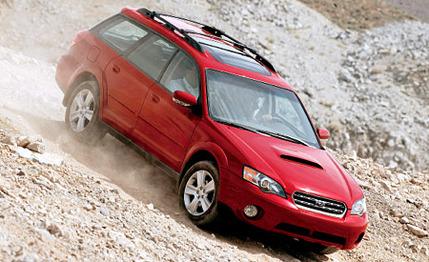
 Road Test
Road Test
Lake Tahoe, for those of you who've never been there, is solid Subaru country. You see the star-badged four-wheel-drive Subies everywhere you go. At a lunch stop during the company's 2005 Outback introductory drive, most of the staff admitted to owning one Subaru or another.
Obviously, the snowy winter climate in the Sierra Nevada predisposes Tahoans to durable, four-wheel-drive vehicles, and interest in the fleet of new Outbacks was wholehearted. And when the faithful learn that the midrange 2.5XT tested here has a 250-hp turbocharged engine-based on the unit in the WRX STi-that shrugs off most of the effects of power-robbing altitude, these folks will be standing in line at the dealerships.
There are three basic levels of the 2005 Outback, starting with the 2.5i and 2.5i Limited. A 168-hp naturally aspirated flat-four engine powers both of these, with the Limited offering a higher level of equipment.
The 2.5XT and 2.5XT Limited are intercooled turbo versions of the flat-four engine, with 250 horsepower on tap.
Most expensive are the top-dog Outback 3.0R and 3.0R sedan, powered by a 3.0-liter flat-six featuring variable intake-valve timing and lift. The 3.0R is also available in L.L.Bean livery and as the VDC Limited (for "vehicle dynamics control," a system that integrates an all-speed, all-wheel traction-control system with variable-torque all-wheel drive). At about $33,000, it is Subaru's most expensive Outback.
For 2005, the Outback has a slightly longer wheelbase and is 1.3 inches longer overall. It has a wider track, a lower center of gravity, and weighs less than the previous-generation car, despite being stiffer and stronger. Subaru used aluminum panels for the hood, front bumper assembly, and liftgate to reduce weight as well as decrease mass at the car's extremities for better handling. In the drive toward centralized mass, even the battery was shifted rearward.
At 3640 pounds, the 2.5XT Limited we tested isn't exactly svelte, but it isn't too bad for a fully equipped all-wheel-drive wagon, and it certainly performs and feels like a lighter car. A quarter-mile time of 15.6 seconds at 92 mph isn't too shabby for a nearly two-ton wagon with an automatic transmission.
The low center of gravity helps quell roll motions and reduce that tippy sensation you often get in heavy SUVs. And thanks to a steering rack bolted securely to the front suspension subframe, what Subaru calls a "cannon mount," the Outback has very direct responses to the helm. To reduce kickback shock, the rack has an integral shock-damping valve that produces a decent compromise between wheel tremor and feel.
Subaru engineers explained at length that horizontally opposed four-cylinder engines have perfect primary and second-order balance, and the new 2.5-liter engine is indeed amazingly smooth and quiet. The layout boasts other advantages, too, such as a crankshaft that is short and stiff and-since no heavy counterweights are needed -comparatively light.
The engine is short, and its longitudinal location provides a straight shot for the transmission and driveshaft. The new five-speed automatic gearbox looks way long in comparison, but that's because it also houses the front and center differentials, along with the computer-directed multi-disc clutch mechanism that apportions torque in Subaru's so-called variable torque-distribution system. (Models with other engine-and-transmission configurations come with different center-differential systems.)
The "symmetrical all-wheel-drive" mechanism-as Subaru calls it-is mostly utterly transparent, but you can sense its variable operation in certain conditions. Because the torque is directed to the axle with the most grip, you can alter the car's handling characteristics in a corner on a gravel road by adding throttle and having the car transition from understeer to neutral or even mild oversteer simply by staying on the gas. For drivers accustomed to correcting slides, the process can be a little counterintuitive, but you soon become reliant on this useful handling tool.